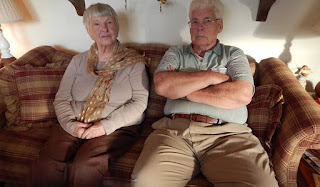L.L. Bean was founded in 1912 in Freeport, Maine, by Leon
Leonwood Bean, to sell a single product – the “Maine Hunting Shoe.” The company
now has about 5,000 employees, and annual sales of $1.61 billion. Its
headquarters is still in Freeport, Maine, and it is still privately owned. The
main About Us page is
Company
Information.
OVERALL GRADE: A
Products/Services: A
minus
The
Company
Information page looks at first like a raging
bore: long, dense, and with headings that are less than enticing (“Current
Corporate Information,” “Products,” “Manufacturing,” etc.). In fact, however, the
page is great corporate storytelling. It explains what the company does, and
where and why and how. As a series of bullet points this sort of information would
be unreadable. It’s fascinating here because we’re given a backstory (for
example, the reason behind each expansion) and provided with several engaging quotes
from past and present leaders of the company.
One quibble: many people read on their phones, where it’s easy
to be interrupted and to lose one’s place on a very long page. A simple
solution would be to split this page into separate pages for Products,
Manufacturing, etc. – with copious links between pages, so that visitors would
still be guided to read them in a certain sequence. Our
Commandment
6 of About Us pages is, “Honor thy visuals.” Shorter pages on a specific
topics could be made even more interesting by including photos from L.L. Bean’s
century-long history.
There are numerous, excellent photos on the timeline,
100
Years and Counting. It’s cleverly compiled so that reading the blurb on
each decade gives a visitor a short company history. The focus is on L.L. Bean,
Inc. – as it should be - but enough national events are listed to set the
context. There’s even an option for customers to share their own L.L. Bean
stories – a great idea. Unfortunately, during our four visits to the site, the
interactive aspect wasn’t working, so we’re not sure we’ve seen all of it.
High marks to the
Newsroom
page, which puts company press releases front and center, but has a sidebar,
“As Seen In,” with links to products featured in sources as diverse as
Redbook,
Elle, and
Field & Stream.
A downgrade: Yes, the company commissioned a centennial
anniversary book, entitled Guaranteed to
Last: L.L.Bean's Century of Outfitting America, by Jim Gorman.
(CorporateHistory.net was not involved with it in any way.) Alas, there’s no
reference to it on the history pages. To find it, we had to enter “book” in the
product search box. If you’re still selling your corporate history book, why
not make it easy to find?
Personality: A
The
Company
History page is also long, dense, and excellent. It begins as the story of
an outdoorsman with wet feet, and tells how he solved the problem with the
original “Maine Hunting Shoe.” Bean’s early trials and tribulations – 90 of his
original 100 pairs were returned – establish the company’s dedication to
quality and customer satisfaction. This is business history at its best.
Quotes from the founder and from later leaders liven up the
text, as do occasional fascinating factoids. We learn, for example, that by the
1930s, L.L. Bean’s mail-order business comprised more than 70% of the volume of
the Freeport post office, and that the flagship store has no locks, because
it’s open for business 24/7.
The list of awards at the end of the
Company
History page would get more attention if it were on a separate page, with
logos, but it’s great to see so many confirmations of L.L. Bean’s status collected
in one place.
In a lovely change from celebrating one’s centennial and
then forgetting about company anniversaries for 10 or 25 years, the
Company
History page ends with highlights of L.L. Bean’s centennial year. Here
you’ll find quick bullet-point references to the aforementioned centennial
book, as well as the timeline—but these should be hyperlinked.
The
Leadership
page is top-notch. Why? Because the bio of the founder and his three successors
all focus on the values that drive them as leaders of L.L. Bean, and on the
results they achieved there. Even the philanthropic activities and hobbies mentioned
reflect the values of the company: for example, membership in the Audubon Society
and the Nature Conservancy. Our
Commandment
3 of About Us pages is, “Reveal thy personality.” We’ve seldom seen that
done better than on L.L. Bean’s site.
Accessibility: A
How many times have you flinched from phoning a company’s Customer
Service line because you were worried that the representative wouldn’t be able
to speak English? L.L. Bean’s
Customer
Service page begins with a characteristically forthright note: no matter
how you communicate with the company (there are options for Phone, Call Me,
Chat, Email, and more), you’ll be speaking with a person in Maine: “because
Maine is more than just an address – it’s part of who we are. It’s tough
winters, Yankee ingenuity and a unique character you just won’t find
elsewhere.”
TAKEAWAY
Your company may not have the size or the hundred-hear
history of L.L. Bean, but it’s unique in who founded it, where it’s been, and
where it’s heading. Make your About Us page reflect that uniqueness with great
content, well told.
Does your Web site’s “About Us” section
accurately convey your organization’s history and capabilities? Every two weeks
we evaluate one example, grading it in three areas that are key to potential
customers: Personality (Who are you?), Products/Services (What can you do for us?),
and Accessibility (How can we reach you?). To talk about your About Us page, contact us!
Today’s example was chosen at random;
CorporateHistory.net has no ties to this company, although we have been
satisfied customers for years.







